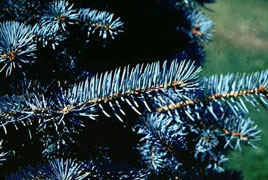


Home
Flowers &
Indoor Plants
Fruits & Nuts
Ornamentals
Vegetables
Special Topics
Resources
Glossary

|
Blue Spruce; Colorado Spruce picea pungens (pie-see-ah punn-jenns)   
 Click on thumbnails for larger image. |
 |
What about it? The blue spruce is a narrowleaf evergreen. At a glance, it looks very much like other needle leaved trees: pines and firs. However, if you look very closely, you can see the differences between them all. Spruce needles grow individually out of the branch, whereas pine needles come in clusters of 2,3, or 5 needles. The needles of the blue spruce are about an inch long and are slightly twisted. They have four sides and when you break one in half the cross section is square or diamond-shaped. Firs have flat leaves. The leaves have a bluish tint, giving the tree its distinctive name. They grow outward at right angles from the branch, as opposed to fir leaves that grow on the sides of the branches. Furthermore, when you pull a leaf off of the branch, a little knob will remain. If you pull a leaf off of a fir tree it makes a hole. What is it used for? The blue spruce is a tall (70 feet) and dense tree which makes it great for a windbreak, a screen, or a barrier. Its blue color makes it a popular decorative tree. Where does it grow? How do we grow it? The blue spruce is very tolerant of almost any conditions. It will do best in moist, well-drained soil. Plant them 25 feet apart or 15 for a screen or a windbreak. What are its primary problems? The blue spruce can be affected by spruce mites, spruce gall adelgids, and Cytospora canker. As they age they tend to lose their lower branches. Several needle cast diseases can also be problems.
© Copyright, Department of Horticulture, Cornell University. |